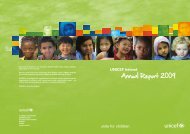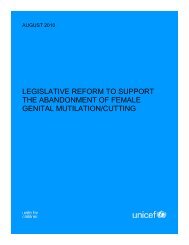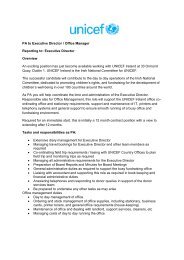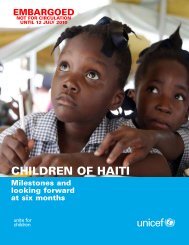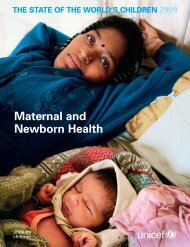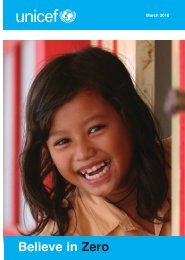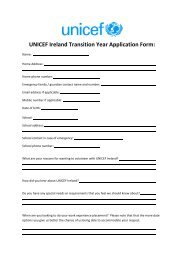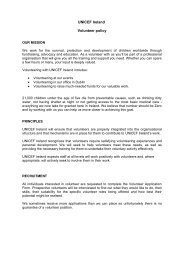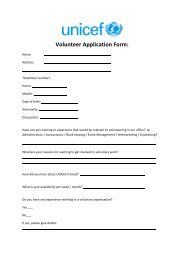Tajikistan, struck by an earthquake, floodsand a polio outbreak in 2010, had receivedonly 3 per cent of funding needs as of October2010. Despite this shortfall, UNICEF, in closecollaboration with World Health Organizationand the Government of Tajikistan, was ableto respond to a major polio outbreak throughthe launch of a rapid and comprehensivepolio campaign that successfully containedthe virus. UNICEF, diverting funding fromother sources, also responded to the floodaffectedpopulation in Kulob District, whereapproximately 2,000 people benefited from anemergency hygiene campaign. Approximately300 households received water containers,hygiene kits, soap and water purificationtablets. More than 1,000 teachers in 510schools in the 20 most disaster-prone districtswere trained in simple and effective disasterrisk reduction measures. Psychosocial supportwas provided to an estimated 750 childrenand 560 adults following the earthquake inVanj District.With higher funding levels, much more couldhave been achieved in these countries as wellas in other crisis-ridden countries featured inthe <strong>Humanitarian</strong> <strong>Action</strong> Report 2010.UNICEF funding requirements<strong>for</strong> <strong>2011</strong> humanitarian actionIn <strong>2011</strong>, US$1.4 billion is needed to supportUNICEF-assisted humanitarian action in 32countries and territories. 27 Compared to the2010 appeal launched in February 2010,this requirement increased 21 per cent, withthe bulk of funding needs represented byPakistan and Haiti, requiring US$296 millionand US$157 million respectively. As shown inFigure 1.4, the financial needs <strong>for</strong> emergenciesin Asia-Pacific have significantly increased andrepresent the region with the highest fundingrequest: US$373 million. Of the funding <strong>for</strong>Asia, 80 per cent is needed <strong>for</strong> assistance toPakistani children and women affected byflooding and conflict.The requirements <strong>for</strong> Latin America and theCaribbean have increased eightfold, mainlyas a result of emergency situations in Haitiand the addition of the Guatemala appeal.Although such precarious conditions asthose in Colombia also require a scaled-upresponse, the increase is linked to promotingpreparedness throughout the region as wellas support <strong>for</strong> smaller-scale emergencies.Figure 1.4 Estimated emergency funding needs by region, 2010 and <strong>2011</strong>Source: UNICEF Office of Emergency Programmes, end 2010Asia-Pacific207373Eastern andSouthern Africa308370West and Central AfricaMiddle East andNorth Africa253263248266Latin America andthe CaribbeanCentral and Eastern Europeand the Commonwealthof Independent States21135183<strong>2011</strong>20100 500 100 150 200 250 300 350 400US$ (millions)10 <strong>2011</strong> UNICEF <strong>Humanitarian</strong> <strong>Action</strong> FOR CHILDREN | www.unicef.org/hac<strong>2011</strong>
The 2010 regional requirements <strong>for</strong> Centraland Eastern Europe and the Commonwealthof Independent States (CEE/CIS) have alsoincreased with the inclusion of the Kyrgyzstanappeal as well as increasing needs in Tajikistan.Requirements <strong>for</strong> Eastern and Southern Africahave been significantly reduced, particularly insuch countries as Burundi, Eritrea and Uganda.While maintaining funding requirements <strong>for</strong>preparedness following the Sudan referendum,overall requests in West and Central Africaand the Middle East and North Africa havealso been reduced.UNICEF’s ability to undertake humanitarianassistance depends entirely on funding fromdonors. UNICEF gratefully acknowledgesdonors’ strong response during 2010 andinvites supporters to maintain or increasetheir commitments to fostering resilience andmeeting the humanitarian needs of childrenand women in emergencies during <strong>2011</strong>.1. Barbara Walter, ‘Conflict Relapse and the Sustainability ofPost-Conflict Peace’, Input Paper, WDR <strong>2011</strong>.2. DARA, ‘Climate Vulnerability Monitor 2010: The state ofthe climate crisis’, , accessed 25 January <strong>2011</strong>.3. Almedom, Astier M. and James K. Tumwine, ‘Resilience toDisasters: A paradigm shift from vulnerability to strength’,African Health Sciences, vol. 8 Special Issue, December2008, p. 1.4. Pelling, Mark, Adaptation to Climate Change: From resilienceto trans<strong>for</strong>mation, Routledge, New York, <strong>2011</strong>, p. 44.5. Institute <strong>for</strong> National Security and Counterterrorism, Projecton Resilience and Security, ‘Resilience in Post-ConflictReconstruction and Natural Disasters’, Workshop Report,Syracuse University, 9 March 2009, ,accessed 25 Jan uary <strong>2011</strong>.6. World Health Organization, Regional Office <strong>for</strong> SouthAsia, C’Community Resilience in Disasters: How theprimary health care approach made a difference in recentemergencies in the WHO South-East Asia Region’, 2010,, accessed 25January <strong>2011</strong>.7. Kirmayer, Laurance J., et al., ‘Community Resilience: Models,metaphors and measures’, Journal de la santé autochtone,November 2009, , accessed 25 January <strong>2011</strong>.11. Steward, Frances, ‘Horizontal Inequalities as a Cause ofConflict: A review of CRISE findings’, Input paper <strong>for</strong> WorldBank World Development Report <strong>2011</strong>, August 2010.12. See <strong>for</strong> example STEPS Centre, Reframing Resilience,STEPS Briefing 13, , accessed 25 January <strong>2011</strong>.13. DARA, Haiti One Year On, ,accessed 12 January 2010.14. Report of the Secretary-General on International cooperationon humanitarian assistance in the field of naturaldisasters, from relief to development, A/65/3568, September2010, p. 2.15. World Disasters Report 2004. Focus on community resilience,International Federation of Red Cross and RedCrescent Societies.16. Omamo, Steven, Ugo Gentilini and Susannah Sandstrom,‘Innovations in Food Assistance: Issues, lessons andimplications’, in From Food Aid to Food Assistance, WorldFood Programme, 2010, p. 2.17. Ibid., p. 31.18. Report of the Secretary-General on Peacebuilding in theimmediate aftermath of conflict, June 2009, pp. 10, 15.19. Active Learning Network <strong>for</strong> Accountability and Per<strong>for</strong>mancein <strong>Humanitarian</strong> <strong>Action</strong>, The State of the <strong>Humanitarian</strong>System, ALNAP, London January 2010, pp. 9, 35.20. National Oceanic and Atmospheric Administration, ‘2010Tied <strong>for</strong> Warmest Year on Record,’ 12 January <strong>2011</strong>, , accessed 25 January <strong>2011</strong>.21. OCHA (2009), using EM-DAR, Climate Change: Coping withthe humanitarian impact, Campaign PowerPoint presentation,slide 12, , accessed 25 January <strong>2011</strong>.22. Ganeshan, Shamanthy and Wayne Diamond, (2009), Forecastingthe numbers of people affected annually by naturaldisasters up to 2015. Oxfam GB.23. The 2010 HAR includes 16 countries and regions that werepart of a Consolidated Appeals Process (CAP).24. Other appeals include ‘Immediate Needs’ documents andinter-agency appeals (excluding CAP and Flash Appeals).25. All funding requests through the <strong>Humanitarian</strong> <strong>Action</strong>Report 2010 refer to figures updated as per mid-yearreview.26. US$45.8 million was provided through the rapid responsewindow and US$41.5 million through the underfundedwindow.27. Twenty-eight country appeals were included in the<strong>Humanitarian</strong> <strong>Action</strong> Report 2010. The Congo was addedthrough the HAR mid-year review. New countries includedin <strong>2011</strong> are Burkina Faso, Cameroon, Djibouti, Guatemalaand Kyrgyzstan. Remaining funding needs <strong>for</strong> Guinea andMauritania, with their own appeals in 2010, have beenincluded in the West and Central Africa regional chapter<strong>for</strong> <strong>2011</strong>. In contrast to 2010, UNICEF offices in Guinea,Mauritania and Nepal have not included an appeal in the<strong>2011</strong> UNICEF <strong>Humanitarian</strong> <strong>Action</strong> <strong>for</strong> <strong>Children</strong> publication.8. International Federation of Red Cross and Red CrescentSocieties, World Disasters Report 2004: Focus on CommunityResilience, 2004.9. Organisation <strong>for</strong> Economic Cooperation and Development,‘Concepts and Dilemmas of State Building in Fragile States:From fragility to resilience’, OECD/DAC Discussion Paper,March 2008.10. Evans, Alex and David Steven, ‘The Resilience Doctrine’,World Politics Review, 7 July 2009, , accessed 25 January <strong>2011</strong>.www.unicef.org/hac<strong>2011</strong> | <strong>2011</strong> UNICEF <strong>Humanitarian</strong> <strong>Action</strong> FOR CHILDREN 11




